When we switched from dry kibble to a raw food diet for our 2 dogs about a year ago, we weren’t sure it was the right choice at first.
Would they eat it? Is it really safe? Will they have problems digesting it well? Those, and many more questions, made me nervous about making such a drastic change.
But a year later, I’ve found the best raw food diet for dogs that works great for our German Shepherds, and they’re thriving on it!
Why We Chose A Raw Diet
The decision to switch from dry kibble to a raw food diet wasn’t one that we took lightly. Both of our dogs, Sasha and Tahlen, had always done OK on their dry food until a couple of years ago.
 Each one started having some itchy skin issues, their coats were thinning and rougher, and they were both prone to yeast infections in their ears. Their vet suspected allergies, with their food being the probable culprit.
Each one started having some itchy skin issues, their coats were thinning and rougher, and they were both prone to yeast infections in their ears. Their vet suspected allergies, with their food being the probable culprit.
So we started on the search for a better food and to try to find out what ingredients they could be allergic to. We started off with minimal ingredient kibble, which Sasha somewhat ate, but Tahlen hated.
Over the course of about a year, we tried 3 different specialty dog foods. In order for Tahlen to eat enough to keep his weight up, we had to add canned food as well.
The result was that neither dog made an improvement with their allergy symptoms, and we were spending a huge amount of money on this specialty food.
In addition, Sasha was gaining way too much weight. This was alarming since she had already torn her CCL on her back right leg and had to have surgery a couple years earlier.
Her surgeon warned that she could likely tear her other CCL in the future, especially if she got overweight. So it was important to keep her lean.
That led me to research more options, and I found the BARF Diet. Sounds kinda weird, right?
BARF stands for Biologically Appropriate Raw Food. Basically, the diet consists of raw meat, organs, and bones, supplemented by vegetables, grains, and fruits.
Next, I want to share with you the benefits of the BARF diet that convinced me to give it a try!
Benefits Of A Raw Diet
There are numerous benefits for your dog with a BARF diet, and I can testify that we’ve seen many of them in Sasha and Tahlen during the last year. Among them are:
- Better food digestion

- Reduction in the number of allergy symptoms
- Shinier and healthier coats
- Higher level of stamina and energy
- Much better weight control
- Smaller stools
- Better mobility
- Healthier immune system
When looking at a choice between highly processed kibble/canned food and the natural meat, bones, and organs that dogs have eaten for thousands of years, we had no trouble making the decision to go raw.
What I wasn’t prepared for, though, was the amount of resistance I received from so many people, and even some from our vet! It seemed that a lot of it centered around the idea of handling so much raw meat.
But I live with a meat and potatoes man. So not many days go by that I’m not cutting up a chicken, mashing ground beef into a meatloaf, or cooking up pork chops. So I was confident that safe practices while preparing the food weren’t going to be a problem.
 A far as our vet, their concern was mainly that the dogs get the proper nutrition. But I showed them how I researched the diet and what ingredients we were going to use, and then scheduled an appointment for a recheck after 3 months.
A far as our vet, their concern was mainly that the dogs get the proper nutrition. But I showed them how I researched the diet and what ingredients we were going to use, and then scheduled an appointment for a recheck after 3 months.
What we found was that both dogs not only did well on the BARF diet, they absolutely thrived on it! All of their blood work was good, they had great energy, their coats were healthier, and their allergy symptoms definitely decreased.
The one downside was that Sasha started losing weight pretty fast, which was concerning, but I thought it was due to her increased activity coming out of winter along with the new diet.
While the vet wanted to keep her lean due to her knee issues, she was worried about her keeping a healthy muscle tone.
So I rechecked the amount of food we were feeding them and realized that I had miscalculated! Sasha was getting a few less ounces each day than she should have been.
So we upped her food intake, and by her next checkup, her vet was pleased with her overall health and muscle tone.
I recommend partnering with your vet when switching to a raw food diet. Even though they were a bit doubtful at first, their advice and guidance was extremely helpful in making sure our dogs had everything they needed.
The Diet We Created For Our German Shepherds
The dogs’ diet evolved over the first few months as we learned what ingredients were easier to process and more readily available. Here is what they currently eat:
- Chicken–we use drumsticks whenever possible since the meat/fat/bone ratio is good, and they’re the easiest to grind up.

- Beef–we grind up our own roasts instead of using hamburger
- Venison–whenever we have some available
- Turkey–the bones are harder than chicken bones, so we purchase already ground turkey
- Duck Necks–we grind
- Hearts and Gizzards–mostly chicken plus some beef heart
- Organ Meats–a good variety can be hard to find, we buy a ground mixture that makes up about 10% of the meat in the diet
- Green Tripe
These ingredients make up about 20% of their total diet:
- Whole Eggs–including the shell
- Carrots
- Broccoli
- Celery
- Apples
- Yogurt
- Brown Rice
The chicken and beef are the biggest portion of their diet, at approximately 40% chicken and 15% beef. The amounts of the other meat and poultry are dependent upon availability and what’s on sale.
We haven’t used pork yet, but will be incorporating it into the diet when we pick up our butchered pig later this month. After doing a lot of research, I feel comfortable that today’s pork is a healthy choice for our raw dog food.
Green tripe is the content and stomach lining of grazing animals, like cows or goats. It has good bacteria, enzymes, and much needed nutrients. You’ll hate the smell, but your dog will love it!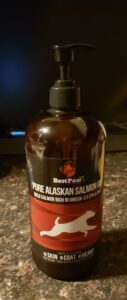
The non-meat ingredients play a vital role in making sure that they get a wide variety of vitamins, minerals, and some carbohydrates.
Initially, we also included fresh salmon, but it’s extremely expensive in our area. So we opted for a high quality wild Alaskan salmon oil supplement instead.
The only other supplement we use is glucosamine for Sasha. She has arthritis developing in her knees, and we’ve definitely seen a difference in her mobility with a glucosamine tablet twice a day!
But one thing we’ve learned over the last year about our BARF diet is to not stress about making sure that the dogs get exact amounts of each ingredient every day.
The proportions change based upon things like sales and discounts, unavailability of items, and simply forgetting to buy something. We live in the country, and if you forget, you do without!
All that really matters is that over a period of a week or a month, the dogs get everything they need.
How We Prepare And Store Raw Dog Food
We prepare about 4 weeks of raw dog food at a time, which is about 110 lbs. worth. All the meat and poultry stay frozen until the day we’re ready to grind up a batch.
About 5 hours before we’re ready to start, I set all the frozen ingredients out on the table to start thawing. They’re still half frozen when we start to grind.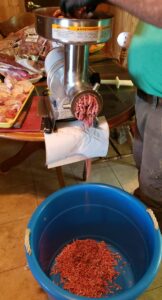
This makes it easier to run through the grinder and, most importantly, ensures that all the raw meat stays very cold throughout the whole process.
While waiting for all the meat to thaw, I prepare the brown rice and refrigerator it. The rice is the only cooked food in this diet, and it’s included as a healthy whole grain at the advice of our vet.
Next, I run the whole eggs, carrots, broccoli, apples, and celery through a food processor. Tip: We learned that having a heavy-duty unit makes this process a lot easier!
Once the meat is about half thawed, we start to grind it up. A large plastic tub with handles holds everything and is great for mixing it up. We grind about 90 lbs. of meat at once, but didn’t start out that way.
We’ve learned several ways to make the process easier and more efficient:
~ Get a quality meat grinder–We initially started off with a small grinder that worked OK whenever we made things like deer sausage. But now we wanted to grind up a big volume that included bones, it didn’t take long to realize that we needed a larger one.
We invested in a quality grinder and are very glad we did! It’s well worth it for anyone who’s feeding large breeds or multiple dogs a raw diet.
~ Plan your batches–It will be much easier to mix your ground meat and the other ingredients if you divide your meat into batches and mix everything after each one.
For example, we might grind up 2 packages of chicken legs along with a beef roast and a package each of tripe, organ meat, and turkey. Then we’ll add a portion of the veggies and egg mixture, mix it all well, and repeat.
~ Get a good mixing tool–We started using a long-handled auger that was designed for digging out weeds, and put it in our drill. I can’t tell you how much that helped!
My husband smoothed off the pointed bottom so the auger wouldn’t dig out the bottom of the plastic tub. Here’s a quick video that shows how it works:
Once the food is all ground and mixed, we divide daily portions into plastic containers. Then into the freezer they go, and we’ve got 4 weeks of dog food!
How Expensive Is A Raw Food Diet?
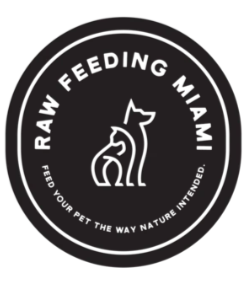 If you’re comparing the BARF diet to regular dry kibble, it’s definitely quite a bit more expensive. If you’re buying specialty food, like we were, the cost is comparable.
If you’re comparing the BARF diet to regular dry kibble, it’s definitely quite a bit more expensive. If you’re buying specialty food, like we were, the cost is comparable.
But when we looked at the benefits of a raw diet for the overall health of our dogs, it was a no brainer. Over the last year, we’ve learned how to reduce the cost.
I keep track of the sales at my local grocery stores and stock up when I can.
A variety of organ meat has been the most difficult to find, but online retailers offer a wide selection. My favorite is Raw Feeding Miami because of the quality and price.
I’ve recently joined a co-op where the cost of some items is literally 50% off the price at my local stores. They have a drop off once a month at a location that’s about 20 minutes away, and that delivery charge is just $15. This has significantly lowered our cost.
Over the next few months I also plan to look up other raw feeders to see if we can partner with them for larger bulk ordering. That will result in even further savings.
The Best Raw Food Diet For Dogs
I believe the best raw food diet for dogs will give them everything they need to have better mobility, a strong immune system, and great overall health.
Our German Shepherds are thriving, and we’ve seen their health improve since we switched from a kibble based diet. So for us, this was the right move.
What do you think about a raw food diet? Is it something you’d like to try for your pooch? Let me know in the comments below, along with any questions, and remember…
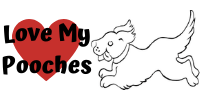
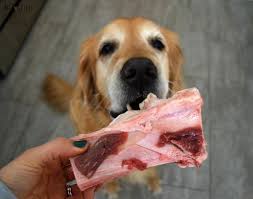


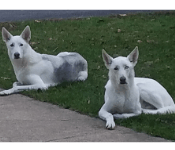
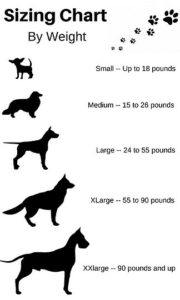



This is such a wonderful post Janelle. Considering our domesticated dogs closest ancestors are wolves and they eat raw meat, it only makes sense that our family pooches would thrive off of such a diet as well. I am not surprised that your Vet had reservations about you switching them to this diet, I am however surprised they didn’t push you to purchase so expensive brand of food they themselves were promoting instead. I am however very glad that it all worked out in the end. I have done a lot of reading online that suggests making food like this for our dogs and cats is much better than anything you can buy in store. I am so happy for you that your two are doing so well on their new diet.
Thank you, they are definitely doing well on the raw diet. Our vet has been a wonderful resource, only being concerned with the quality and safety of what we were feeding them. I’m always grateful for them and believe that finding a vet that you can trust is probably one of the biggest decisions you can make for your dog’s welfare.
Sharing your experience here with your pet is really helpful as this will go a long way to also help other dog owners on how to help their dog eat healthy. Honestly you really took a bold step to feed your dogs with raw food diet, something that most people are skeptical about. I’ve read somewhere online about how unhealthy it may be to feed your dogs with raw meat. But learning from your experience has clarify things a bit. When I have a dog of which I’m planning to, I’ll consider following this BARF Diet plan.
We’re happy that we made the switch to the BARF diet and can wholeheartedly recommend it. If you consider it, definitely partner with your vet to ensure that your dog gets all the nutrition and minerals that they need. I have no doubt that your dog will love it as much as mine do!
Hello there, thanks a lot for sharing this beautiful piece of information here with us. I must say i really did enjoyed going through your review as it contains valuable information’s one can hold on to. I have been on a raw for diet for some time now for my dog, and i can tell you that it is really effective as you can see the changes in their daily behavior and activities.
I’m so glad you’re having great results with your dog on a raw diet as well. If you have any tips or lessons you can add, I’d love to hear them!
Hello Janelle,
I really didn’t know about these amazing benefits that come with feeding with don’t with a raw diet and I feel like I have deprived mine better health and wellness condition for so long. Although she is doing very good from her current meal plan these are benefits I would love for her to benefit from. Her stamina level would be very useful because she loves to run
Ours love to run as well, and they keep the squirrels on their toes, lol!
Our decision to change to a raw diet came from the problems that both dogs were having with traditional dry dog food. If you are considering switching diets, I’d definitely talk with your vet to see the best way to do it, especially since you say your dog is doing very well on her current diet.
Oh, a good post, a very good one on what the best raw food diets are for dogs and I’m very sure that I would want to buy one for my dog especially after reading this here. I learnt online somewhere that raw foods are not really too good for the dogs but now I see that that’s just a lie and the diets that you have researched and used really does work. This is something I’d like to try too. Thanks!
Raw food diets for dogs can be very controversial, and if they’re not prepared well, it’s likely that they won’t get the right nutrition. One of the reasons that I think many vets and owners are against raw diets is because too many people don’t take the time and effort to make them well balanced and diversified .
There are those who think that throwing a chicken leg or some hamburger in a bowl is a raw diet. But if you work with your vet and ensure that your dog is getting everything they need for complete nutrition, a raw diet could be an option for your pooch too!
Very good to see that this panned out well for your dogs. I have been advised to try out raw foods for my dog too though I haven’t yet but with this that I read here, I feel I can give the go ahead and give trial to this here. I really fancy all shared in here and definitely well worth it. Thumbs up to you for sharinf
Thank you so much, and I hope your dog loves the raw food diet as much as mine do!
Hello there! this is an amazing review you have got here. I am sure these quality informations in this post will be of great help to anyone who come across it. One other benefits I have personally found about raw food diet is that it gives the dog Cleaner teeth and fresh breath.
Thanks for sharing this with me.
You’re definitely right about cleaner teeth and fresher breath–thank you sharing with us!
Putting your dog on a raw food diet is really good as it eliminates a lot of unnecessary carbohydrates, So it a very good to help your dog lose weight and maintain a very good and healthy condition…But some times it has proven to be a lot more dangerous so it’s advised if you are to give them raw food especially meat it may not be a live animal as it might make your dog get a little more aggressive.
Feeding live prey is definitely not recommended and would be dangerous and unethical. For those who want to feed a whole prey model diet, there are retailers where they can purchase them.
One of my favorite suppliers of raw food for my dogs offers whole prey that is ground up, such as rabbit and duck. It’s RawFeedingMiami.com, and I’ve been extremely pleased with all of their ethically sourced products.
Great information! It’s the first time I heard about BARF diet and it seems that it’s the best way to go. We are about to get our pup in two weeks (Rat Terrier), and we are so excited. My husband had a few dogs in the past and he’s very good on taking care of them… in a loving way. Thank you for sharing!
You’re welcome, and I hope your pup enjoys his diet as much as our dogs do!
Thank you so much for sharing the tips for feeding a raw diet. I have been looking into it, but hadn’t decided to make the change yet for my dog. It definitely takes more effort, but the benefits really seem to outweigh the extra work and cost. I’ll be sharing your article on my Facebook page!
We’re very happy we made the change and are seeing the positive effects in both dogs. I appreciate you sharing my post with others!
The only food I know for dogs are those available from dog food stores. I never thought about raw food diet. Honestly speaking this is the first time I encountered this idea of feeding domesticated dogs with raw foods. I thought that this kind of diet is for wild dogs only.
I have two German shepherds both almost two years old. Let me try your suggestion. Thanks for sharing.
We wouldn’t have known about alternative diets for our dogs if it hadn’t been for the research we did because of their allergies. I’ll admit that the idea of preparing a raw food diet didn’t sound good to me at first, lol.
But I found that it was much more popular than I thought, and now I really feel good about what we’re feeding our dogs. If your German Shepherds are anything like ours, they’ll love it!
Ohhhh my first time to hear a BARF diet. I never thought egg shells can be thrown into the mix. My German Shepherd likes white rice, and my other dog (a Japanese Spitz) eats what we eat–including fried fish. I was hesitant to do that at first, but since he “eats everything”, I gave it a go. No skin or general health issues so far. He still runs quick even if he’s 10 years old already! Awww I love dogs, thank you for this! Made me think more mindfully about how I prepare my dog’s food (who eats everything anyway). 🙂 Cheers, A
When I first learned about the BARF diet, I was very surprised by all the different options for feeding a dog other than dry kibble. I actually didn’t see how you could feed dogs food that had egg shells in it, but then I read about other raw feeders who just gave their dogs a whole egg and they ate it! So when I tried adding some crushed up eggs to Sasha and Tahlen’s food, I wasn’t surprised that they just gobbled it up.
It’s good to know that your dogs are doing well, and thanks for stopping by!
Okay! I actually like the fact that you are not writing this based on assumptions but based on what you have actually tried out which gives more credence to this post a nd makes it more trustworthy to help in making a decision for myself and what my dogs would actually value more. I have a Labradors and though I don’t actually focus more on raw foods, it feels good seeing them here and I might consider adapting it too
I’ve had Labradors during a lot of my life and just love them! My love for dogs and all the things I’ve learned through the years is what inspired me to start my blog. If you decide to try a raw diet and have any questions, I’ll be happy to answer to the best of my ability!